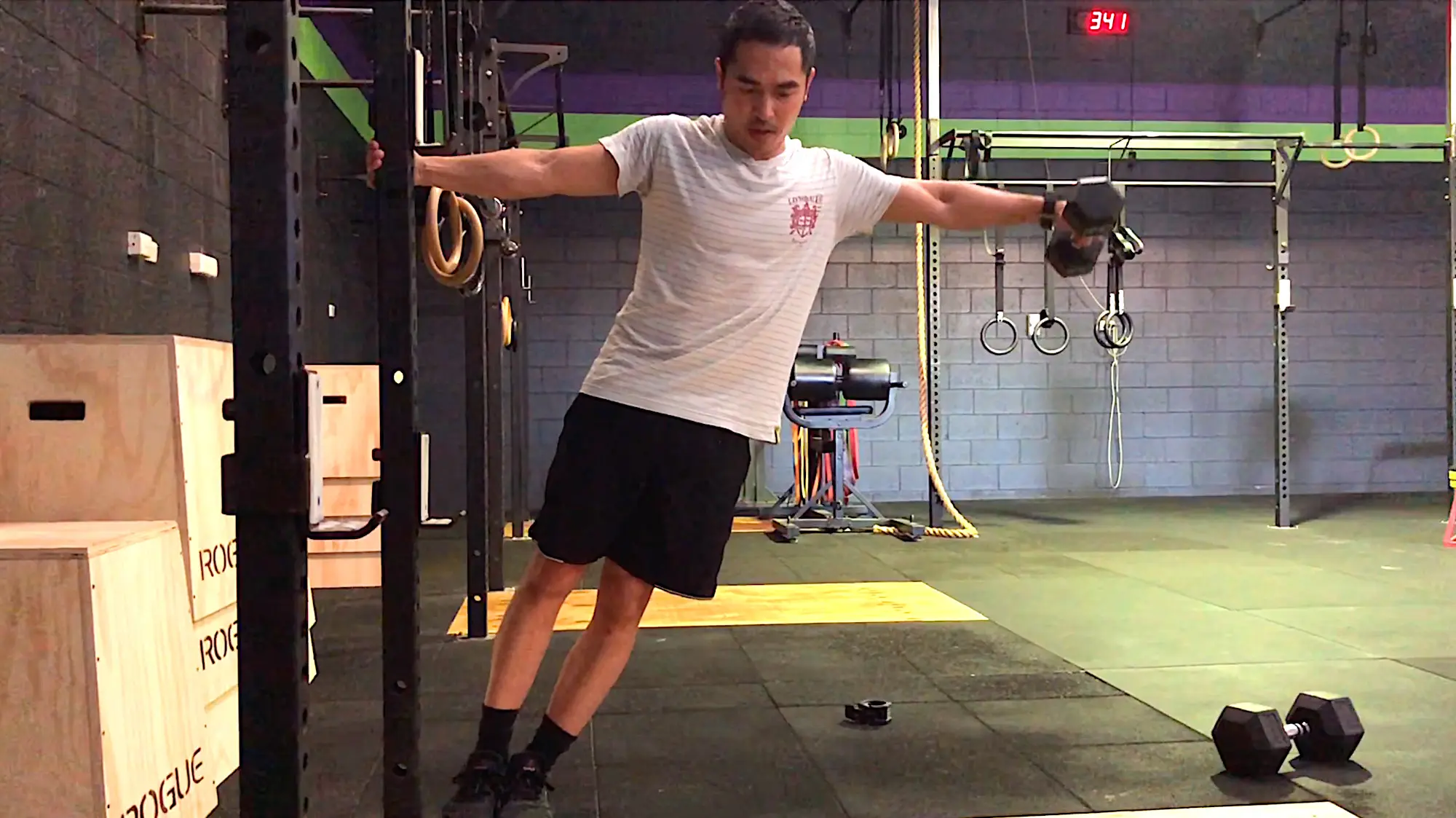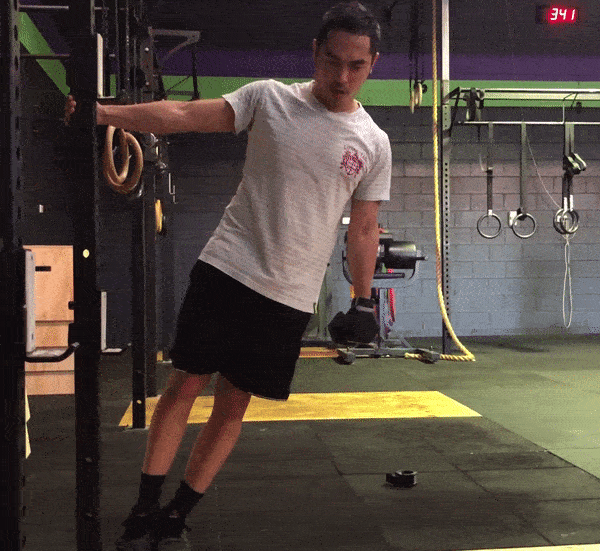
The best online fitness resource you'll ever need. We filter out the BS to ensure you meet your health and fitness goals!

The best online fitness resource you'll ever need. We filter out the BS to ensure you meet your health and fitness goals!

The ‘Egyptian’ lateral raise is a variation of the classic version. It is essentially a unilateral form of the lateral raise in which you lean at an angle, whilst holding onto a support with your non-working hand.
Like its classic counterpart the Egyptian lateral raise is a potent shoulder-building exercise, designed to isolate the deltoids (particularly the anterior and medial deltoids) for hypertrophy across low stimulus, high rep sets.
Developing your deltoids can have multiple benefits.
For starters, broad, well-shaped delts are key to achieving the v-taper that many people are looking to gain from their training. Alongside wide lats, they will give you broad shoulders, a slim-waisted appearance (that has little to do with chest development, contrary to popular opinion!)
The unilateral nature of the Egyptian variation also allows you to really zone in on your deltoid mind-muscle connections on each side. The lean lengthens the movement’s range of motion, giving you a greater workload across more muscle mass and, as a result, achieving greater stimulus and hypertrophy.
Good mind-muscle connection and mass through your delts are also vital in maintaining upper body strength and mobility.

In short, you want to perform the regular lateral raise at an angle.
However, we can, of course, do better than this.
With regular lateral raises, you would generally take a dumbbell, plate, or kettlebell in each hand. With a straight back and a tight, braced core, you would then slowly lift your arms out to the side. A slightly scooping motion works best; rather than simply flapping your arms upwards, act as if you are scooping your hand under a bar set a shoulder height (it makes more sense in practice, and helps to bring your deltoids into greater isolation from the traps).
You would raise them to shoulder height, hold for a breath, then lower them under control. Then you would repeat for higher rep ranges (12+) for your desired number of sets.
Egyptian lateral raises share enough base DNA with the regular lateral raise that a lot of the above still applies to them. However, there are a couple of differences, as mentioned above.
To modify your lateral raises to Egyptian versions, simply:

These basic movements will give you a good shoulder workout. However, there are a few things to bear in mind that can make your Egyptian lateral raises both safer and more effective.
A subtle adjustment to your starting position can place more of the tension into your delts, further isolating them from the rest of your body. Begin each rep by moving your hand slowly out to the side. Lean slightly forwards, keeping your chin and chest up, your collarbones broad. Raise the weight a couple of inches to the side, pause for a breath, then begin your rep.
Don’t worry too much about what the hands are doing. They are holding the weight, but they are not leading the movement. Pay more attention to the elbows. They should lead each rep, forming the highest part of your arm throughout. Raise them to shoulder height, hold, then return – this will further emphasize your deltoid contractions.
With this in mind, rotate your wrists slightly at the top of each rep. Each rep should finish with your pinky fingers highest. This will help you to lead your shoulder and will further emphasize your medial delts, which can otherwise be quite hard to target.
Remember, too, that this isn’t a power move. We’re going for lightweights and maximum time under tension. Keep it deliberately light as you begin. You should never have to bring in any other part of your body to assist the movement. Raise your arm slowly, under control. Hold for a breath at the top, then lower your arm even more slowly than you raised it.
The shoulders can be hard to grow. Large movements like chest presses, overhead presses and rows will target them to a degree, but generally only in a supporting role. The back, chest, and arms generally do a lot of the work.
This is where isolation work comes into its own – you can use isolation movements to spot target those hard to get to areas, giving them time to shine (and fatigue and grow, which is our ultimate goal).
Lateral raises in general are amongst the best isolation movements for developing shoulder muscularity. Egyptian raises simply dial this up a notch.
The unilateral nature will allow you to overcome any natural imbalances, which happen to most of us. As above, it will also allow you to focus on building your mind-muscle connection with each side, individually. This is a core component of strength and hypertrophy – the importance of mind-muscle connection cannot be overstated in weight training.
The lean also allows for a greater range of motion. More muscle will be recruited, leading to more growth. The joint will also be opened up and worked through a greater range, leading to greater overall mobility.

The main pitfall with the Egyptian lateral raise is the same as the lateral raise’s main benefit – we are talking about isolation work, with all the negatives that entail.
This is mostly a lack of efficiency and a lack of global use.
Isolation movements are inefficient as they work small amounts of muscle mass, taking quite a long time on them. Overhead presses allow you to work your full torso and core, lift it more, and elicit greater overall strength and hypertrophy.
The lack of global use means, essentially, that in isolating muscle groups, you are missing an opportunity to coordinate multiple joints and muscle groups together. This kind of coordination is vital in improving strength and athleticism.
However, these downsides needn’t be too bad. Variety is key. In any given shoulder workout, you should employ heavy, large compounds. Begin with overhead presses or seated military presses, for example. Then, when you’ve burned yourself out with them, move onto your isolation movements.
You get the best of both worlds, then, using each to plug the other’s deficits.
If you’re doing any kind of lateral raise correctly, you should be using your deltoids and little else. Of course, supporting muscles will come into play. You will want to brace your core and keep it solid and stable throughout each movement. Your traps will inevitably become involved, especially as you fatigue, and you will feel the stimulus through your arms.
However, this should all be limited. Try to keep as much in the deltoids as possible.
In this way, you will really be able to put the work where it is needed: into the anterior and medial deltoids.